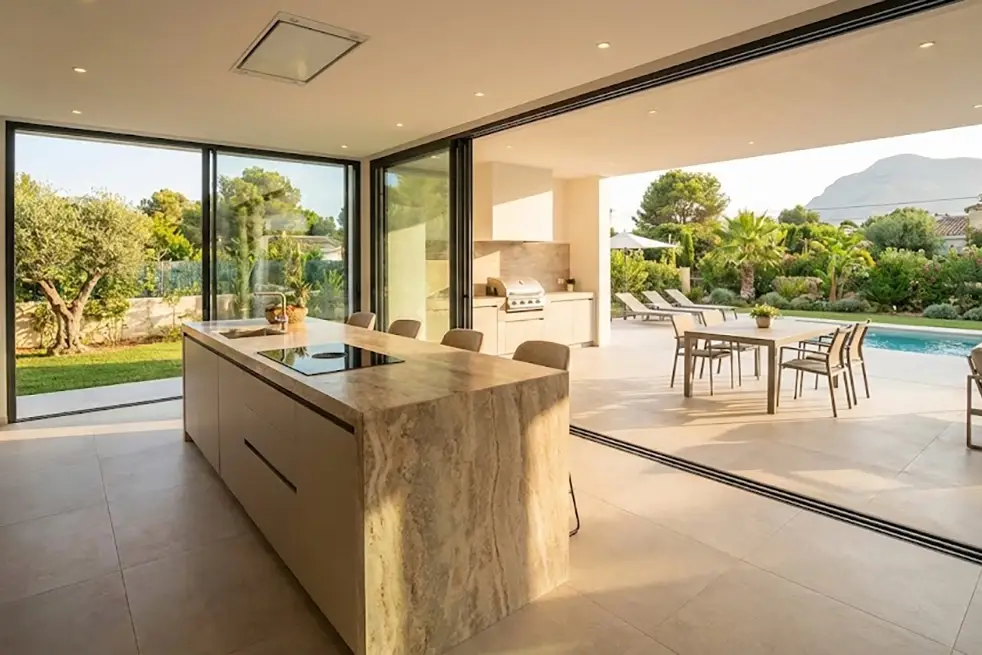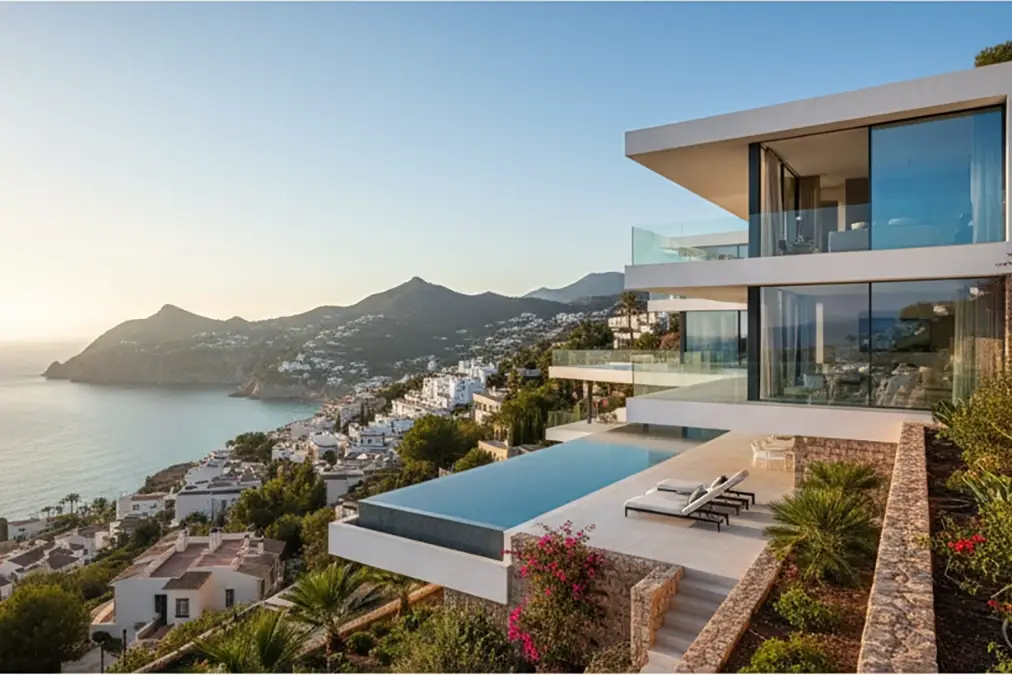Choosing between flat or pitched roofs in the Costa Blanca is not just a matter of style. The type of roof impacts the home’s durability, energy efficiency, and how the outdoor space can be used.
The decision should be based on the local climate, the design of the project, and the intended use of the roof. In this article, we help you assess both options through architectural experience and in-depth knowledge of the Mediterranean environment.
Flat or pitched roofs in the Costa Blanca
Traditional Mediterranean architecture is dominated by pitched tiled roofs. They are a familiar feature in the urban landscape of many towns across Alicante, Valencia, and Castellón.
However, in recent years, modern architecture has embraced flat roofs as a symbol of elegance and spatial efficiency. Each option has its advantages and limitations, and they are not always interchangeable.
The mediterranean climate and Its influence on roofs
High sun exposure all year round
The Costa Blanca enjoys over 300 days of sunshine per year. This makes flat roofs an attractive option for installing terraces or solar panels.
Occasional but intense rainfall
Rainfall is infrequent but can be very heavy. In such cases, a pitched roof drains water more quickly, preventing build-up.
Salty environments near the sea
In coastal areas, salt can accelerate material deterioration. That’s why it’s crucial to choose well-protected construction systems, especially for flat roofs.
Advantages of flat roofs in warm climates
Flat roofs allow the upper space of a home to be used in many ways: from a terrace to a garden or solarium.
In addition, their clean, horizontal design fits well with modern homes, giving them a contemporary and functional look. They also offer easy access for maintaining systems such as aerothermal units or solar panels.
Benefits of traditional pitched roofs
Pitched roofs are designed to facilitate drainage. Their slope offers better protection against heavy rain and damp conditions.
Aesthetically, they bring warmth and tradition, fitting well in areas with heritage regulations or uniform visual styles. They are also more tolerant of small buildups of debris without compromising waterproofing.
Maintenance: A key factor
Which one requires more upkeep?
In general, flat roofs require more frequent maintenance. It’s important to check drains, joints, and waterproofing—especially after rainfall.
Pitched roofs need less maintenance, though loose or wind-displaced tiles should be monitored.
Cleaning and access
Access to flat roofs is easier, making inspections more convenient. In areas with nearby vegetation, it’s important to regularly clear leaves and debris.
Architectural aspects and bespoke design
Style of the home and its surroundings
The roof design should be in harmony with the overall style of the project. In modern homes, a flat roof enhances straight lines and minimalist aesthetics.
In contrast, in rural or traditional settings, pitched roofs help the building blend in harmoniously.
Local urban planning regulations
Some municipalities on the Costa Blanca—such as Altea, Moraira, or Jávea—restrict the type of roof allowed in certain areas. In zones with landscape or heritage protection, a minimum roof pitch may be mandatory.
Durability and structural performance
A well-executed pitched roof can have a very long lifespan with minimal maintenance. Its design prevents leaks even during heavy rain.
Flat roofs are also durable, but they require greater technical precision and high-performance materials to ensure waterproofing.
Which option is better for the Costa Blanca?
There is no single answer. It all depends on the type of home, its location, the intended use of the roof, and the local planning regulations.
Both roof types are viable if designed with the right technical approach. The key is to adapt them to the surroundings and the client’s lifestyle.
Practical examples in local architecture
At La Quinta Fachada Arquitectura, most of our homes on the Costa Blanca feature flat roofs. This is due to their versatility and the type of architecture our clients seek: modern, functional, and connected to the outdoors.
They also allow for the creation of spaces such as viewing terraces, rooftop gardens, or shaded areas. Of course, each project is carefully studied. When the setting or regulations require it, we also design pitched roofs or mixed solutions.
This combination allows us to balance design, functionality, and regulatory compliance—always delivering the best possible result.
Final recommendations for choosing the best roof
-
Analyse the specific climate of your plot and its orientation.
-
Always check local planning regulations before designing.
-
Consider the future use of the roof.
-
Rely on a professional team with local experience.
Frequently asked questions about roofs on the Costa Blanca
Can I freely choose the type of roof?
Not always. It depends on the local regulations and the type of land where the house is being built.
Are flat roofs more expensive?
Not necessarily. They require more specific waterproofing materials but can also reduce other costs.
Are flat roofs safe for children?
Yes, as long as they are designed with appropriate safety railings.
What if I want to install solar panels?
Both types of roofs allow it, but flat roofs make it easier to adjust the orientation and carry out maintenance.
Do pitched roofs provide better insulation?
Both can offer good thermal insulation if properly built.
Which adds more aesthetic value to the home?
It depends on the desired style. Flat roofs provide a modern look, while pitched roofs give a more classic and cosy feel.
Opinion
Choosing between flat or pitched roofs on the Costa Blanca is not a minor decision. Each option has its own advantages that should be assessed from a technical, aesthetic, and functional perspective.
At La Quinta Fachada Arquitectura, we guide our clients through this process, ensuring that every choice aligns with their lifestyle and the environment where they plan to build their home.




